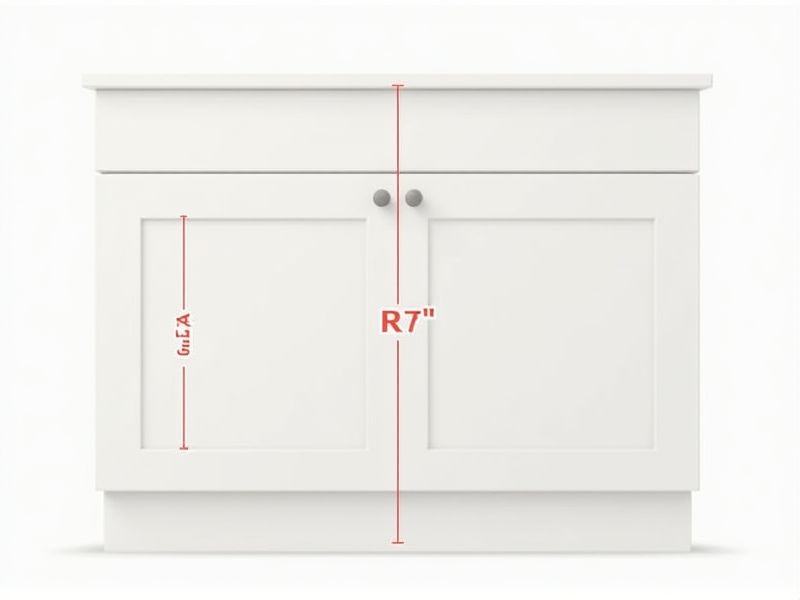
When planning cabinetry for a kitchen, bathroom, or office, knowing standard cabinet dimensions can help you design efficiently and avoid costly mistakes. For base cabinets, the typical height is 34.5 inches (excluding countertop), with a standard depth of 24 inches and widths ranging from 9 to 48 inches in 3-inch increments. Wall cabinets usually are 12 to 42 inches tall, 12 inches deep, and come in similar width increments. By starting with these standard measurements, you can ensure your cabinets fit appliances properly and leave enough space for comfortable movement and effective storage.
Base Cabinet Height
The standard base cabinet height is typically 34.5 inches, which provides a comfortable working surface while standing. This height does not include the countertop, which usually adds another 1.5 inches, bringing the total to around 36 inches. When designing your kitchen, consider the importance of a well-thought-out cabinet height to enhance usability and accessibility. Proper alignment with appliance heights and counter space can significantly improve your workflow and overall kitchen experience.
Base Cabinet Depth
The standard base cabinet depth typically measures 24 inches, providing ample storage space while maintaining accessibility for kitchen activities. When designing your kitchen, consider that this depth allows for standard countertop installations, which usually range from 25 to 26 inches, including an overhang. Furthermore, shallow base cabinets with a depth of 12 to 18 inches are available for compact spaces, maximizing functionality without sacrificing style. Proper depth ensures not only sufficient storage but also a cohesive flow in your kitchen layout.
Base Cabinet Width
Base cabinet width typically ranges from 24 inches to 36 inches, with 30 inches being a popular choice for kitchen designs. The standard depth is generally 24 inches, allowing for both practicality and ease of access to kitchen items. Height usually measures around 34.5 inches, ensuring compatibility with standard countertops, which are often 36 inches tall when accounting for an additional inch for countertop thickness. Custom options are available if your design requires specific dimensions to fit your unique space.
Wall Cabinet Height
The standard wall cabinet height typically measures between 30 to 42 inches, depending on kitchen design and ceiling height. For an average ceiling height of 8 feet, a 36-inch wall cabinet is commonly used to provide optimal storage while allowing for ample counter space. It is essential to leave a minimum of 18 inches between the countertop and the bottom of the wall cabinet to ensure comfortable food preparation and cooking. When planning your kitchen layout, consider these dimensions to maximize both functionality and aesthetics.
Wall Cabinet Depth
Wall cabinets typically have a standard depth of 12 inches, which provides sufficient space for kitchen essentials while maintaining a streamlined appearance. This depth is ideal for accommodating most dishware, glasses, and pantry items without protruding too far into the room. Choosing wall cabinets with a depth of 12 inches maximizes vertical space and enhances the overall aesthetic of the kitchen. When planning your kitchen layout, consider how this standard depth will interact with countertops and appliances to ensure functionality and flow.
Wall Cabinet Width
When considering wall cabinets, the standard width usually ranges from 12 to 36 inches, allowing you to optimize your kitchen or storage space effectively. Many homeowners opt for widths of 30 or 36 inches to create a balanced look while maximizing storage capacity. It's crucial to measure your available wall space accurately to ensure a proper fit, as cabinets that are too wide or too narrow can disrupt the visual flow. Your choices in wall cabinet widths can significantly impact both functionality and aesthetics in your home environment.
Toe Kick Height
The standard toe kick height for cabinets is typically set at 4 to 6 inches, providing a comfortable clearance for the feet and aiding in ease of cleaning beneath the cabinetry. This height ensures that you can easily access the lower shelves and maintain ergonomic posture while working in the kitchen or bathroom. When designing custom cabinetry, it's crucial to consider this measurement to align with your specific needs and overall kitchen aesthetics. Adjusting the toe kick height can enhance functionality and contribute to a cohesive design in your space.
Countertop Height
The standard countertop height for kitchen cabinets typically measures 36 inches from the floor, ensuring comfort and efficiency for most users. In addition, custom options can range from 30 to 39 inches, accommodating varying user preferences and needs. When planning your kitchen layout, consider the overall ergonomics, as optimal countertop height can significantly enhance the cooking experience. Remember, adjustable cabinets may offer flexibility for both taller and shorter individuals, promoting better accessibility and ease of use.
Upper Cabinet Height From Floor
The standard height for upper kitchen cabinets typically ranges from 54 to 72 inches above the floor, depending on the ceiling height and user preferences. This measurement allows for optimal storage while ensuring ease of access, particularly for individuals of average height. For best ergonomic results, the space between the countertop and the bottom of the upper cabinets should ideally be 18 inches. If you are taller or have unique kitchen design plans, consider customizing your cabinet placement to enhance functionality and aesthetics.
Cabinet Door Size
Cabinet door size typically ranges from 12 to 48 inches in width and 24 to 96 inches in height, catering to various design preferences and spatial requirements. Standard cabinet doors can be found in modest styles such as shaker or raised panel, providing versatility for kitchens and bathrooms. When choosing cabinet doors, consider the overall layout; for instance, larger doors can make a significant visual impact, while smaller doors maximize convenience in tight spaces. You should also factor in the door thickness, generally 0.75 to 1 inch, which affects durability and aesthetic appeal.
